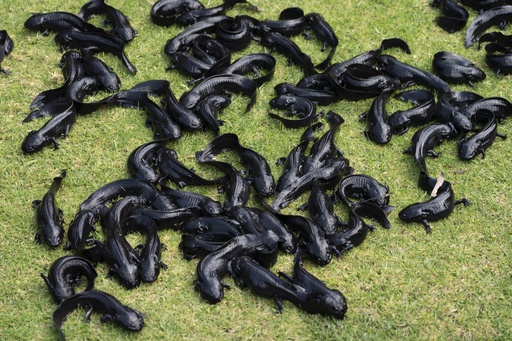
MEXICO CITY — According to lore, the axolotl isn’t merely an amphibian; it is said to have once been a mischievous deity. This creature, which has become a cultural icon in Mexico, has inspired numerous conservation efforts to safeguard its existence in the face of extinction.
Yanet Cruz, who leads the Chinampaxóchitl Museum in Mexico City, described the axolotl as a fascinating animal. The museum showcases exhibitions that concentrate on both the axolotl and the chinampas, which are ancient agricultural systems reminiscent of floating gardens, still in use today in Xochimilco, a section of the city famous for its canals.
“Although multiple varieties exist, the local axolotl represents an essential part of the identity for indigenous peoples,” Cruz noted, participating in events that marked “Axolotl Day” in early February.
The exact population of axolotls is currently unknown, but the species Ambystoma mexicanum, native to central Mexico, has been categorized as “critically endangered” by the IUCN Red List of Threatened Species since 2019. While many—scientists, historians, and officials—have been dedicated to protecting this species and its natural environment, a different sort of preservation movement has arisen unexpectedly.
International interest surged in axolotls after the popular video game Minecraft included the creature in 2021. That year also saw Mexicans rallying to embrace the axolotl following a Central Bank initiative to feature it on the 50-peso bill. “That’s when ‘axolotlmania’ really took off,” Cruz remarked.
This unusual amphibian has appeared in various artistic expressions throughout Mexico, from murals to crafts and even socks. Some bakeries have gained popularity with treats resembling axolotls, and a local brewery has named itself “Ajolote,” honoring this beloved salamander and its cultural ties.
Before the arrival of Spanish conquerors in the 16th century, the axolotl may not have been depicted in archaeological finds like the rain god Tláloc or the lunar goddess Coyolxauhqui. However, it did appear within ancient Mesoamerican records. In one Nahua myth, the god Nanahuatzin leaps into fire, reemerging as the sun and urging the other gods to join him in sacrifice. All complied except for Xólotl, associated with the evening star, who attempted to evade capture.
“He was tracked down and ultimately killed,” explained Arturo Montero, an archaeologist with the National Commission of Protected Natural Areas. “From his demise emerged a creature: the axolotl.”
Montero elaborated that this myth suggests that upon the death of a deity, its essence transforms into a common creature, tied to the cycles of life and death. Thus, the axolotl carries the spirit of Xolotl within, and upon its passing, this divine essence returns to the underworld only to reappear later in a new axolotl.
“The axolotl is akin to maize, agave, and water,” Montero remarked, asserting that the increasing reverence for axolotls and their historic sacredness isn’t merely happenstance, but rather likely fueled by their remarkable biological traits.
Within a fish tank, the axolotl can be quite elusive. Its skin often appears dark, enabling it to blend in with stones, although there is a breed that presents in an albino, pinkish hue. These amphibians can remain motionless for long periods, often hiding in the muddy bottoms of their natural habitats or barely stirring in captivity.
Axolotls possess both lungs and the ability to breathe through their gills and skin, which allows for adaptability in aquatic settings. Remarkably, they boast the ability to regenerate parts of their hearts, spinal cords, and even brain tissues.
“This species is indeed unique,” commented biologist Arturo Vergara, who oversees axolotl conservation initiatives at various organizations, also taking care of sales specimens at a hatchery in Mexico City. Prices for axolotls at Ambystomania—where Vergara works—start at 200 pesos ($10 US), depending on their species, color, and size. “They are easy to take care of, and once they achieve a length of four inches, they become available for sale,” he noted.
“Typically, they can live for 15 years in captivity, although some have reached up to 20 years,” he added. “In their natural habitat, however, they likely only survive around three to four years.”
The specimens at the museum represent one of the 17 known varieties in Mexico, all endemic to lakes and canals that currently face pollution challenges. As it stands, the existing axolotl population grapples with feeding and breeding issues.
“Picture the muddy bottoms of canals in places like Xochimilco, Tlahuac, and Chalco—teeming with microbes,” Vergara pointed out. Ideally, an axolotl could recover from a heron or snake bite and survive the dry months by burrowing into mud, but favorable aquatic conditions are a prerequisite for this to occur.
“Protecting the axolotl goes hand in hand with preserving the chinampas,” Cruz stated at the museum, standing by a showcase featuring axolotl-shaped dolls. “We collaborate closely with the community to emphasize the importance of this area.”
Chinampas serve as not only breeding grounds for axolotl but also the spots where ancient cultures cultivated crops such as maize, chili, beans, and zucchini. Some members of Xochimilco’s current inhabitants continue to engage in vegetable farming despite ongoing environmental issues.
“Many chinampas have dried up and are no longer productive,” Cruz remarked. “And where some chinampas were once situated, you might now find soccer fields.”
For both Cruz and Vergara, the goal of protecting the axolotl symbolizes a broader effort to conserve the environment that nurtured this remarkable creature.
“This remarkable system of chinampas represents the remnants of the lake city of Mexico-Tenochtitlan, so I always remind our guests that Xochimilco is a living archaeological site,” Cruz concluded. “If we don’t actively protect what belongs to us, it will eventually vanish.”

